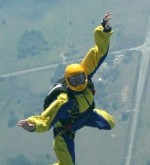When Bulls have wings…

There is a group of USF students looking for an adrenaline rush. They risk their lives, jumping out of airplanes at 13,500 feet with nothing more than a parachute strapped to their backs.
These individuals belong to USF’s South Florida Skydiving Bulls (SFSB), a club dedicated to the enjoyment and appreciation of the sport of skydiving.
Skydiving is a social sport. Participants can jump with nearly anyone. However, there are times that the SFSB club members jump together. Brothers Scott and Greg Wilson, both members of the club, already have their 34th and 38th jumps, respectively. They agree that they love this sport more than any other.
Scott went bungee jumping and said “this is nothing compared to sky diving.” He admitted that he gets nervous every time he jumps, but said that it is definitely worth it.
“I was more scared in the plane than I was once I got out,” he said. “Once you finally get out of the plane, you can relax a hundred times more and enjoy.”
Greg has wakeboarded and done a lot of kite surfing, but “the coolest thing about (skydiving) is falling with other people. The whole experience is just unbelievable. There’s really no word that can describe it. There is no other sport out there that you can really have the excitement and the rush that you get from this.”
Robert Banfield, the president of the SFSB club said that he had his first tandem freefall when he turned 18 years old. He described his first tandem jump as the “most fun I ever had in my life.”
After seven years he decided to become a licensed skydiver. He took skydiving classes, eventually earning his “C” license, which indicates a coach rating and allows him to jump with students. He skydives five to ten times a week. As a doctoral student in his last semester at USF, skydiving relaxes him from the pressures of writing his dissertation. On Saturday, he completed his 217th jump.
Banfield also explained that skydiving is initially a pretty expensive recreation, but that after he finished all the training and purchased his own gear, “it is not much at all.” He encourages students of USF and all those who live in Tampa to take advantage of the proximity of Skydive City in Zephyrhills, which is only 22 miles away.
Veena Rayapareddi, an Indian national who now resides in Tampa, said that she was not nervous at all about skydiving because she loves heights and loves to experience bizarre things. She landed on the drop zone laughing and screaming and exclaimed: “It was an unbelievable experience! I would suggest everybody to do it.”
Tandem jumping is believed to be the easiest for a first-timer. It requires a 15-minute training session, after which the jumper is harnessed to an instructor who wears and operates a parachute for two people. After jumping out of the plane from 13,500 feet, the tandem accelerates to about 120 miles per hour and the freefall lasts for about 60 seconds. The instructor may allow the first-time jumper to maneuver the parachute as they descend to the ground. The parachute ride lasts for about five minutes.
Accelerated Freefall (AFF) is a seven-level freefall training program, in which one can learn the basic skills to advance to solo or group skydiving.
“Skydiving is a high-risk activity which may cause or result in serious injury or death.” This is a warning written in one of the billboards in Skydive City. But it doesn’t scare the participants.
According to David “TK” Hayes, a manager at Skydive City, the establishment is Florida’s No. 1 skydive drop zone with an average of 6,500 jumpers per year; 3,500 tandem jumpers and 3,000 regular jumpers.
Hayes has exciting and horrible memories of skydiving, but he still jumps. He recalls that in his eleventh jump in 1982, he landed on a tent. This is where he got his nickname “TK” which means “tent killer.” He had a more serious accident, but he still loves skydiving and has now done about 6,800 dives.
Members of SFSB are afforded a discount when jumping through Skydive City. Students who want to become a member can register for free by logging on to OASIS. Though Skydive City is privately operated, it gives discounts to the SFSB club members. According to Laurie Clark, an instructor at Skydive City, a tandem jump costs $183. USF club members pay $140. Any students with valid ID who are not members of the SFSB pay $163. Those who possess their own equipment pay $20 a jump. Videos of the jumps cost $96. First-time skydivers receive certificates after their jump. Discount cards are also provided to second-time skydivers.






